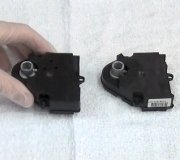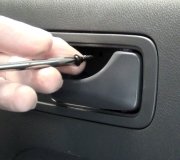Hi guys. I'm here to save the day, ... I hope! Part of the confusion stems from there were two version of this car model, and I always get them mixed up. One is a 100 percent Mitsubishi car with Chrysler's name on it. As I recall, that is the hardtop / LXi model. The other is a Chrysler-built product that is a convertible. Other than being a convertible, it is a twin to the Stratus and Cirrus. The base radio for the domestic version was an AM / FM / cassette radio or a low-end Chrysler-built AM / FM / CD player. The high-end radio in both car models was a Mitsubishi-built AM / FM / CD / cassette combo radio. That radio is by FAR the highest-quality radio I have ever worked on. If that is what you had in your car, there is nothing you can install that will sound better or be easier to use. I used to sell a lot of these for upgrades when people bought a used car and wanted to upgrade from a cassette player to a factory CD player. Even if you don't own a cassette, this is the radio that is most desirable. The high-end AM / FM / CD-only radio was built by Alpine. Those were high-quality too, but Alpine refused to allow Chrysler to sell us their radio service manuals. I had no trouble getting manuals for Chrysler-built or Mitsubishi-built radios.
The next part of the confusion, as shown by the four dandy wiring diagrams in the first reply, is 2000 through 2003 is when various car models switched from the common, two-plug radios to the single, white plug with 22 pins. The newer plug has two rows of 11 pins in each row. The older plugs were black and gray, each with seven pins. One pin on the end of each plug isn't used in all applications.
The third variable is the higher-end systems used a remote amp, either under the front passenger seat, as you found, or individual amplifiers mounted on four of the speakers. With GM and Ford systems, when a radio is used with a remote amp, it must be used with an amp, otherwise the volume will be way too low to hear, and when their radio is not used with a remote amp, it can't be used with an amp. GM and Ford have dozens of different radio model numbers every year that look the same but have slight differences inside to match their tone response to the shape of the vehicle. Your chance of getting the correct radio model from a salvage yard is pretty low. The wrong radio will work fine, but a purist can tell the tone response isn't quite right.
All Chrysler radios will work in any vehicle they plug into, regardless if it has an amp or not. Chrysler amps do not increase volume or power. They are strictly for tone conditioning for the shape of the specific vehicle. There are only a few radio model numbers each year. One of the biggest differences is with the mounting ears. By far, the most common had one ear on the right side, near the top, and on the bottom, near the left side. One less-common version was used on '93 - '95 Jeeps, and an even less-common version was used on the Stratus / Cirrus. 2003 was the last year for this style radio with the two plugs, used on the full-size vans. A few car models switched to the newer 22-pin plug in 2000, and all the car models used that by 2004.
Chrysler didn't vary much in the colors of the wires they used over the years. I don't now if that holds true for Mitsubishi-built cars. I've snipped dozens of plugs from cars in salvage yards to use on my display boards, and have never found anything other than red and pink wires for the two 12-volt feeds. I was surprised to see a white / black shown in these diagrams for the 12 volt switched, and orange / black for the 12 volt memory. It would appear all four of these diagrams are for the Mitsubishi-built cars. These drawings down below are of the two plugs with the typical domestic wire colors. I hand these out at old car show swap meets. Note that the numbering for the gray plug is backward on Chrysler radios compared to Mitsubishi diagrams, but the locations within the plug are the same. You will find there was a wire in terminal number seven on the black plug in your car. That gets 12 volts switched onto it by the radio when the radio and the ignition switch are on. That is the turn-on signal for the remote amplifier. There can be a second wire there for the "up" signal for an optional power antenna.
If you're going to "down grade" to a "one-size-fits-all" aftermarket radio, the remote amp will not be used. It will need to be bypassed if you want to use just the new radio to run the original speakers directly. Remember, that amp is just for tone conditioning, but that only applies to the tone response of the original radio. Chrysler radios meant to be used with an amp put out very little bass. That is made up in the amplifier. Those are referred to as the "Infinity" systems. If a non-Infinity radio, including aftermarket radios, is used with an amp, there will be too much bass unless that tone control is turned way down. Too much bass is not natural, and sounds muddled.
Most higher-end aftermarket radios have normal amplifier stages built in to run speakers directly, but when you need a suitcase-sized amp in the trunk, they usually have a pair of RCA cables that will plug into those amps. The radio still uses the volume control, but this would be like the GM and Ford systems that must be used with a remote amp somewhere. The RCA cables come off before the radio's built-in amp, so without the unit in the trunk, the sound won't be loud enough to hear.
To address your problem of cut wires, it sounds like that is irrelevant because you aren't going to be using the original amp, speakers, or speaker wiring. If your original radio used the two 7-pin plugs, there will be two 12-volt feed wires in the dash. Sounds like you found those already. There is no ground wire in there. That was made with a braided ground strap or a black wire clipped to the back of the radio. You'll need to attach that to the new radio. Run new audio cables to the new amp, then run new speaker wires to your new speakers.
If your original radio used the newer 22-pin plug, that only has the 12-volt memory wire, but it does have a ground wire in it. Two if I remember correctly. The radio was powered through the memory circuit, but it got its turn-on signal from a digital signal on the pair of data buss wires. If that applies to your car, you'll need to run a new 12-volt switched wire from the fuse box or some other circuit that gets turned on through the ignition switch. Disregard the two data buss wires. IMPALASS is right about sealing the ends of unused wires. The two data buss wires are what all of the multiple computers use to share information back and forth. They originate in the Body Computer, which puts six volts on each one. That computer protects itself in case either wire becomes grounded or they become shorted together, but that will prevent the computers from sending data to each other. That will result in a crank / no-start condition, and on newer cars it can cause a totally-dead electrical system.
The two illumination wires won't work with aftermarket radios. One gets 12 volts switched onto it when the tail lights are turned on. That tells the display to dim. The other one comes from the dash lights. That tells the display how much to dim, and it runs the face plate's back lights. The dimming is done through "pulse-width dimming" which turns the lights on and off about 400 times per second. The ratio of on-time to off-time is varied to adjust the overall brightness. This is a very efficient system that reduces wasted power, but no aftermarket radio I'm aware of is designed to use this system. These wires should be sealed with heat-shrink tubing. I don't like electrical tape because it can unravel into a gooey mess on a hot day. If the dash light wire grounds to the radio's case, it will kill all the dash back lights and other lights tied to that circuit, such as for the shift lever, head light switch, heater controls, and possibly the green or yellow lights in the power window switches. It also has the potential to burn out the dimmer control, which is a small computer module. If the dimming wire grounds out, it will pop the fuse for the tail lights and front running lights. On most models that is also the circuit that feeds the dash light dimmer module, so you'll lose the dash lights too.
For my final comment of value, let me repeat there is no ground wire in the black and gray plugs. That is a separate clipped-on wire or bolted-on ground strap. A lot of people use an ohm meter to find what they think is the ground wire in those plugs. They mistakenly find one or both illumination wires because they read very low resistance to ground through all of those multiple bulbs. When the tail lights are turned on, that fuse blows because current finds its way to ground through that wire being attached to the radio's case, then through the outer shield of the antenna cable. In the event the antenna has a poor ground, the tail light fuse won't blow, but the radio will only work when it gets a ground through all the tail light bulbs. Once the lights are tuned on, the radio quits working because it has 12 volts on the ground circuit.
Images (Click to make bigger)
Friday, January 5th, 2018 AT 6:26 PM















